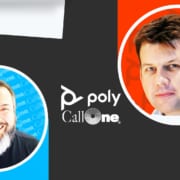What Changes Has Poly Seen in the Contact Center?
We are heading into a year of living and working during a global pandemic. One industry that had to make significant changes is the Contact Center space. What changes has Poly seen in the Contact Center space over this past year?
Today we are joined by Richard Kenny, Sr Product Marketing Manager – Contact Center & Unified Communications for Poly (formerly Plantronics and Polycom) to learn about what they are seeing. Below are some excerpts from our discussion. Watch the video to hear the complete discussion.
Danny: What changes has Poly seen in the Contact Center space over the past year?
Richard: This is one of those significant years where a lot of the trends that we’ve been predicting for a while have suddenly accelerated. We’ve always talked about if you move to cloud and then we started talking a little bit about when you move to cloud. For contact centers that’s turned into two different ways of looking at that. There’s hybrid working from a technology point of view. So, you’re mixing your cloud solution and your on premises solution, and then you also you’re looking at hybrid working from a location view…”
Danny: Does Poly recommend different solutions if agents are working from home vs physical contact center?
Richard: So we think that the solutions that people have got in the office will work as well at home.
Danny: What about this one? (New Savi 7300 Series)
Richard: That would be an awesome one! 30% of call centers are in some sort of financial vertical, and they have a really big focus on security.
Danny: Has Poly seen a change in use of video in contact centers?
Richard: It’s huge, is the honest answer. You know, if you could have predicted a perfect timing for the merger of Plantronics and Polycom, that would have been it. The video is taken off extensively. And that video has been seen as a really big tool for helping keep teams engaged, helping keep teams together.
Danny: Has Poly seen an increase in the need for device management?
Richard: There’s twofold reasons for wanting device management. The first one is you sent everybody home so you can’t see what they’re using anymore. The call center has said they don’t want to be big brother but they do want to guarantee the audio quality…”
Danny: Why should contact centers chose Poly?
Richard: We used to ask about remote agents and you used to ask, “How far away is your furthest away agent?” and people would say, “like 50 miles 100 miles.” We’ve managed a headset that is over 200,000 miles away. So we put the headset on the moon with Neil Armstrong. If you think your agents are far away, we’ve done it further. And what that drives in Poly is this idea of durability, reliability, and audio quality. So if you want the best of those, we’ve proved it through the moon program…
To get all the great information Richard Kenny provided that is not in this blog, watch the entire video. If you would like to schedule a proof of concept or pilot of Poly solutions for your contact center, contact us!





